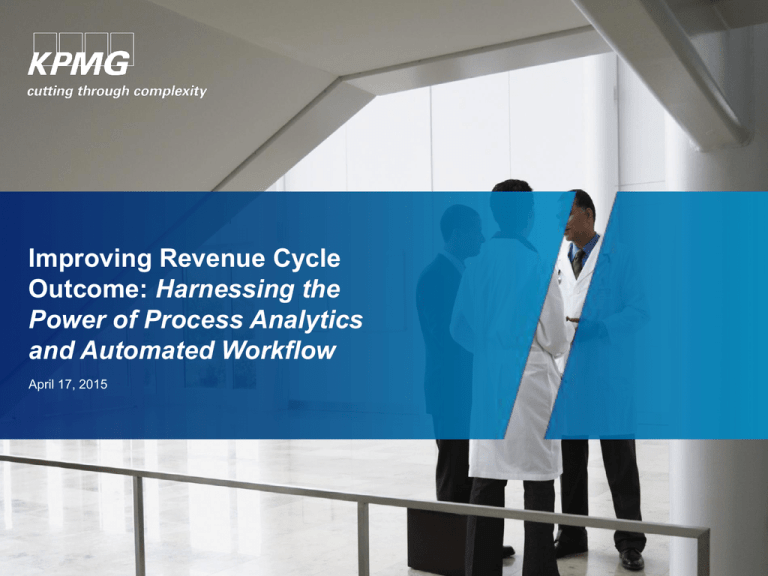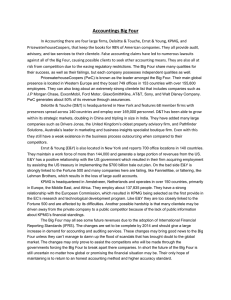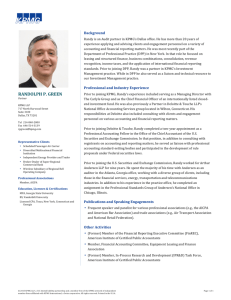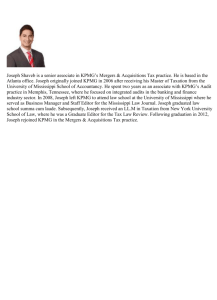
Improving Revenue Cycle
Outcome: Harnessing the
Power of Process Analytics
and Automated Workflow
April 17, 2015
Agenda
Introductions
Baseline definitions
Why these solutions are important
Process analytic concepts
Automated workflow concepts
Using BPM as competitive advantage
Applying business rules to drive higher performance
Evolution of revenue cycle
Q&A
1
Introductions
With us today
Phillip Brooks
Director
KPMG LLP
Over 20 years healthcare experience
Focuses on Revenue Cycle Redesign, Capital Budgeting and
Planning, Vendor Selection and Implementation, and Operational
Efficiency and Cost Reduction
Works with community health organizations, large integrated
providers, and academic medical centers
© 2015 KPMG LLP, a Delaware limited liability partnership and the U.S. member firm of the KPMG network of independent member
firms affiliated with KPMG International Cooperative (“KPMG International”), a Swiss entity. All rights reserved. NDPPS 339426
3
Baseline definitions
Baseline: Definitions
Workflow: repeatable patterns of activity that involve a system of resources, roles, knowledgeable worker
interaction, and information flow
Automated Workflow: a collection of methods and tools used to document, improve, and monitor business
processes as defined by standard workflows
Process Analytics: the ability to access data about individual instances of a process and use that data to
monitor, analyze, and improve an organization’s critical operational processes
Business Process Management (BPM): the combination of Automated Workflow solutions that are
specifically designed for revenue cycle operations and incorporate Process Analytic concepts to create an
interactive system that can automatically prioritize high-value tasks to the right people to improve efficiency
and drive down costs
© 2015 KPMG LLP, a Delaware limited liability partnership and the U.S. member firm of the KPMG network of independent member
firms affiliated with KPMG International Cooperative (“KPMG International”), a Swiss entity. All rights reserved. NDPPS 339426
5
Why these
solutions are
important
Why these solutions are important
Do you need an automated workflow?
Have you driven 20 percent of costs out of your revenue
cycle over the past five years?
Have you improved net revenue annually?
Have you reduced your headcount by 10 percent?
Have you improved processing times by 50 percent?
If you answered “no” to any of the above questions,
you likely need to think about implementing an
automated workflow approach.
© 2015 KPMG LLP, a Delaware limited liability partnership and the U.S. member firm of the KPMG network of independent member
firms affiliated with KPMG International Cooperative (“KPMG International”), a Swiss entity. All rights reserved. NDPPS 339426
7
Evolve your revenue cycle into revenue cycle 3.0
RC 1.0
Traditional assessments,
Recommendations, and
options and
Implementation
Due to a change in
organizational focus or
change in personnel,
benefits erode over time.
RC 2.0
RC 3.0
Automated workflow
design and deployment
Automated workflow
with process enabled
analytics
Automated workflow allows
for repeatable, quicker-paced,
and sustainable
Improvements, even
when personnel changes,
since workflow is hardcoded.
© 2015 KPMG LLP, a Delaware limited liability partnership and the U.S. member firm of the KPMG network of independent member
firms affiliated with KPMG International Cooperative (“KPMG International”), a Swiss entity. All rights reserved. NDPPS 339426
Allows for deeper penetration
into root cause issues and
enables automated workflow
to perform continuous
monitoring of micro-processes
that contribute to delays in
processing bills, delays in
cash flow, loss of revenue,
and increase costs.
8
Using BPM as
competitive
advantage
Using BPM as a competitive advantage:
Transformation through automation
Business Process Management is not just about managing a defined basket of work activities faster or more
efficiently. It is also about improving results.
What can BPM do?
Identify Highest value accounts for follow-up and push them up the queue
Route POS Collections efforts for prescreening by financial clearance staff
Help speed/standardize medical eligibility status processes and tasks
Identify root causes of identified anomalies
Display how a single problem manifests and interrelates across entire revenue cycle
ecosystem
© 2015 KPMG LLP, a Delaware limited liability partnership and the U.S. member firm of the KPMG network of independent member
firms affiliated with KPMG International Cooperative (“KPMG International”), a Swiss entity. All rights reserved. NDPPS 339426
10
Process analytic
concepts
Process analytic concepts: Why the need?
Business need to combine data from multiple systems
Requirement to compare historical and current comparative
analysis to understand improvement strategies
Need to make real-time proactive decisions and move
away from reactive actions
Must find ways to mitigate revenue at risk
Need to view consolidated revenue cycle operations
© 2015 KPMG LLP, a Delaware limited liability partnership and the U.S. member firm of the KPMG network of independent member
firms affiliated with KPMG International Cooperative (“KPMG International”), a Swiss entity. All rights reserved. NDPPS 339426
12
Process analytic concepts:
Benefits of using data analytics
Root cause analysis of denied
claims to reduce at source
Simplify presentation of
actionable management
information allowing for faster
decision making
Rapid identification of daily
productivity performance to take
appropriate actions
Financial
Improvement
Quickly understand process
outcomes to make adjustments
Consolidation of data from
multiple sources to provide
quality scorecards for staff
Job/staff outcomes trending to
monitor work outcomes
© 2015 KPMG LLP, a Delaware limited liability partnership and the U.S. member firm of the KPMG network of independent member
firms affiliated with KPMG International Cooperative (“KPMG International”), a Swiss entity. All rights reserved. NDPPS 339426
13
Process analytic concepts:
Case study #1
Overview
A not-for-profit integrated healthcare system comprising of 12 hospitals whose net patient revenue is
$3.7 billion with total system discharges of 172k.
Problem
Decentralized business offices that did not take advantage of system wide standards and economies of
scale. Disparate patient accounting systems.
Scorecard
Outpace
Improve
Reduce
Equip
Cash goals in the first year of implementation
Denial and underpayment processing by working active issues in
an automated, timely manner
Future denials through root cause analysis and process
improvement
Support the centralized business office strategy while also
redeploying associates to high-value roles
© 2015 KPMG LLP, a Delaware limited liability partnership and the U.S. member firm of the KPMG network of independent member
firms affiliated with KPMG International Cooperative (“KPMG International”), a Swiss entity. All rights reserved. NDPPS 339426
14
Automated workflow
concepts
Automated workflow concepts
BPM is a collection of methods and tools used to document, improve, and monitor revenue cycle processes.
The Process
Revenue cycle processes are modeled to
document current state.
1
2
The revenue cycle processes are
simulated in order to identify gaps.
3
The processes are streamlined through
reengineering to fill gaps and eliminate
bottlenecks.
4
5
Automation is introduced into the
processes wherever possible.
The Result
An undefined,
inconsistent, and
over-complicated
process...
A
B
C
=
D
E
BECOMES
A simplified,
consistent, and
streamlined
process.
The processes are monitored to ensure
improved outcomes are achieved.
© 2015 KPMG LLP, a Delaware limited liability partnership and the U.S. member firm of the KPMG network of independent member
firms affiliated with KPMG International Cooperative (“KPMG International”), a Swiss entity. All rights reserved. NDPPS 339426
A
B
C
=
Unnecessary steps and task variability are reduced
while efficiencies are gained and financial outcomes
are improved.
16
Automated workflow concepts (continued)
BPM is used to identify bottlenecks, delays, loopbacks, and insufficient
resourcing, then improve efficiency and effectiveness through streamlining activities.
Process bottlenecks are delays and
activities that cost an excessive amount of
money and/or time.
Delays occur because there is insufficient
notification that one activity is finished so
that the next one can start.
A process with loopbacks has bad process
design: processes should always move
forward in time and control.
Insufficient available resource pools to
execute an activity can cause a process to
be drawn out, costing time and money.
© 2015 KPMG LLP, a Delaware limited liability partnership and the U.S. member firm of the KPMG network of independent member
firms affiliated with KPMG International Cooperative (“KPMG International”), a Swiss entity. All rights reserved. NDPPS 339426
17
Automated workflow concepts: Additional benefits
According to Info-Tech Research Group, Over 80% of organizations saw clear benefits as a
result of automated workflow implementation.
Adaptability: Increased flexibility, scalability, to react to changes in the industry.
Reliability: Processes are repeatable, automated, and more streamlined, which helps reduce
variability.
Profitability: Aligning RC activities closely with high-value outcomes may positively impact the
bottom line, including increased net revenue and ROI.
Improved efficiency: Identifying the next highest value activity for maximum value in a
repeatable processes contributes to smoother operations.
Predictability: More projects and tasks will be completed on time with a reduced cost model.
Increased productivity and efficiency: Higher request resolution means that end users have
what they need to do their jobs.
© 2015 KPMG LLP, a Delaware limited liability partnership and the U.S. member firm of the KPMG network of independent member
firms affiliated with KPMG International Cooperative (“KPMG International”), a Swiss entity. All rights reserved. NDPPS 339426
18
Effective BPM consists of a five-step lifecycle to maximize
outcomes
1. Modeling
Revenue cycle processes are modeled to
document current state.
2. Simulation
The revenue cycle processes are simulated in
order to identify process gaps.
3. Streamlining
The processes are streamlined through
reengineering to fill gaps and help eliminate
bottlenecks.
4. Automation
Automation is introduced into the processes
wherever possible.
5. Management
The processes are monitored through process
analysis, alerting management when changes
are needed and ensuring improved outcomes.
© 2015 KPMG LLP, a Delaware limited liability partnership and the U.S. member firm of the KPMG network of independent member
firms affiliated with KPMG International Cooperative (“KPMG International”), a Swiss entity. All rights reserved. NDPPS 339426
19
Applying business
rules to drive higher
performance
Applying business rules to drive higher performance:
case study #2
Overview
A not-for-profit integrated health system with an academic medical center comprising of 7 hospitals whose
net patient revenue is $2.3 billion with total system discharges of 108k.
Problem
Lack of technology. Manual processes were inefficient and days in AR were not improving. Operational
teams were not making headway against organizational goals.
Scorecard
Outpace
Improve
Reduce
Equip
Three year risk-adjusted ROI of 435%
Account representative productivity and patient satisfaction – cost
to collect
Future denials through root cause analysis and process
improvement
Providing a single source of truth with data to make better
management decisions
© 2015 KPMG LLP, a Delaware limited liability partnership and the U.S. member firm of the KPMG network of independent member
firms affiliated with KPMG International Cooperative (“KPMG International”), a Swiss entity. All rights reserved. NDPPS 339426
21
Evolution of
revenue cycle
Evolution of the revenue cycle
1980 (DRGs)
Loosely
Managed
1990 (APCs)
2010 (ACOs) Today
Highly manual/paper based
Charge based blended with
cost + reimbursement
Localized Silo
Management
2000
RC departments managed independently
Improvement initiatives didn’t fully consider
total impact
Primarily Cash Flow focus
Localized
Revenue Cycle
Management
Emergence of “Rev Cycle” vs. Dept focus
Denial Management becomes a discipline
Get paid the maximum appropriate
Net Revenue, cash flow, and overall cost mgmt
Enterprise
Revenue Cycle
Management
© 2015 KPMG LLP, a Delaware limited liability partnership and the U.S. member firm of the KPMG network of independent member
firms affiliated with KPMG International Cooperative (“KPMG International”), a Swiss entity. All rights reserved. NDPPS 339426
“Systems Thinking” (ToC) and Connected
Efficiency and value-driven
Big data and guided discovery
Net Revenue and actual cost combination
23
What should you do next?
Evaluate automated workflow capabilities in your current environment
Evaluate Process Analytic capabilities
Build appropriate business case to support BPM deployment
Gain insight into revenue cycle processes and drive significant benefits
© 2015 KPMG LLP, a Delaware limited liability partnership and the U.S. member firm of the KPMG network of independent member
firms affiliated with KPMG International Cooperative (“KPMG International”), a Swiss entity. All rights reserved. NDPPS 339426
24
In summary
New Business Models
At KPMG, we believe that health plans,
providers, and life sciences companies should be
thinking beyond transformation and focus more
on healthcare “convergence” and the broader
implications of operating in a more collaborative
and integrated U.S. healthcare delivery model.
While transformation of current operations is
likely going to be a business requirement, the
real question for forward-looking organizations is
what role they plan to play in a new and more
converged health system.
© 2015 KPMG LLP, a Delaware limited liability partnership and the U.S. member firm of the KPMG network of independent member
firms affiliated with KPMG International Cooperative (“KPMG International”), a Swiss entity. All rights reserved. NDPPS 339426
25
Questions?
Contact information
Phillip Brooks, Director, Advisory
KPMG LLP
330-329-1269
pebrooks@kpmg.com
© 2015 KPMG LLP, a Delaware limited liability partnership and the U.S. member firm of the KPMG network of independent member
firms affiliated with KPMG International Cooperative (“KPMG International”), a Swiss entity. All rights reserved. NDPPS 339426
27
Thank You
Restriction on Disclosure and Use of Data – This document
contains confidential or proprietary information of KPMG LLP,
the disclosure of which would provide a competitive advantage
to others; therefore, the recipient shall not disclose, use, or
duplicate this document, in whole or in part, for any purpose
other than the recipient’s consideration of KPMG LLP’s
services.
© 2015 KPMG LLP, a Delaware limited liability partnership and
the U.S. member firm of the KPMG network of independent
member firms affiliated with KPMG International Cooperative
(“KPMG International”), a Swiss entity. All rights reserved.
NDPPS 339426







